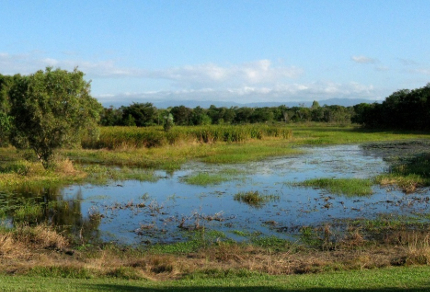In mid-morning, I cycled to the Ross River Bush Gardens simply to feel my legs pedaling and see what was out in the world. I observed no new bird species, but contentedly listed my familiar avian acquaintances identified by song and sight, feeling as though I should inform these urban residents that I’d seen their rural cousins yesterday in the back country between Undara Volcanic National Park and Ingham. Just as rainbow lorikeets fussed and fed in the gums and paperbarks alongside the Ross River here in Townsville, they had fussed and foraged in the eucalypts on cattle stations in the middle of tropical savannah nowhere. Somehow, it surprised me that the lories, and the pale-headed rosellas and red-tailed black-cockatoos, were just out there, and yet, of course, the dry savannah woodland was undoubtedly these birds’ native habitat long before the first shacks were built at the site of what was to become Townsville.
Beyond the Bush Gardens, dry grass stubble was nearly hidden by curved, beige lances of fallen leaves of gums and paperbarks. I birded from the shade provided by pale-barked eucalypts, soaking up the peace inherent in the muted song of the peaceful dove and in the graceful, swooping and darting movements of welcome swallows skimming over the river. A light breeze nudged the water into slight ripples, and white, cotton-candy clouds floated above Mount Stuart’s broken, pink clifffs rearing up in a spectacular backdrop for the riparian scene. A pair of Australian pelicans flapped and glided over the water, their huge black and white wings a whisper away from touching the surface when gliding, as though these stately birds were playing a game with their reflections, although in reality, they may have been scanning the water’s depths for fish.
Fresh, wet scents wafted ashore on warm air, making me loathe to leave the river, as Vilis and I were loathe to leave the Tyto Wetlands late yesterday afternoon. Having completed our backcountry drive from Undara Volcanic National Park to Ingham by mid-afternoon, we lazily strolled around Ingham’s 120-hectare Tyto Wetlands1 for two and a half hours. I birded while Vilis spotted for me and photographed the wetland and its inhabitants, including a young agile wallaby giving its belly a good scratch. We had no schedule, no goal. We were just browsing. And yet, we walked on and on, lured by the mowed paths, by the lotus lilies and bird song, and by the air that changed from mid-afternoon’s cloying, wet-tropical heat to sweet freshness that bordered on coolness before dusk. For a moment, for just a moment, I felt a faint whisper of Canadian autumn in that sweet freshness, a whisper right there in front of me and yet half a world away.

Lotus Lily at Tyto Wetlands (© Vilis Nams)

Tyto Wetlands (© Vilis Nams)
Green pygmy-geese swam among lily pads and lotus lilies that pushed thick, pink puds and grey, dried seed heads into the air. A forest kingfisher perched atop a seed pod, its iridescent blue feathers gleaming above a flotilla of ruffled, green lily pads. Crimson finches looking as though they’d been dipped in raspberry juice clung to grass stalks and flitted about in shrubs at the wetland’s edge. These three avian species made no secret of their presence, unlike a buff-banded rail that crept secretively along beside dense vegetation in a ditch. Egrets, ibises, and an anhinga hunted out in the wetland, and honeyeaters – brown, yellow, rufous-throated – and trillers, orioles, figbirds, bronze-cuckoos, and flycatchers foraged in neighbouring shrubs and trees. As generally ensues after an afternoon lull in activity, the birds became increasingly active as dusk approached, as though they, too, reveled in the cooler air.
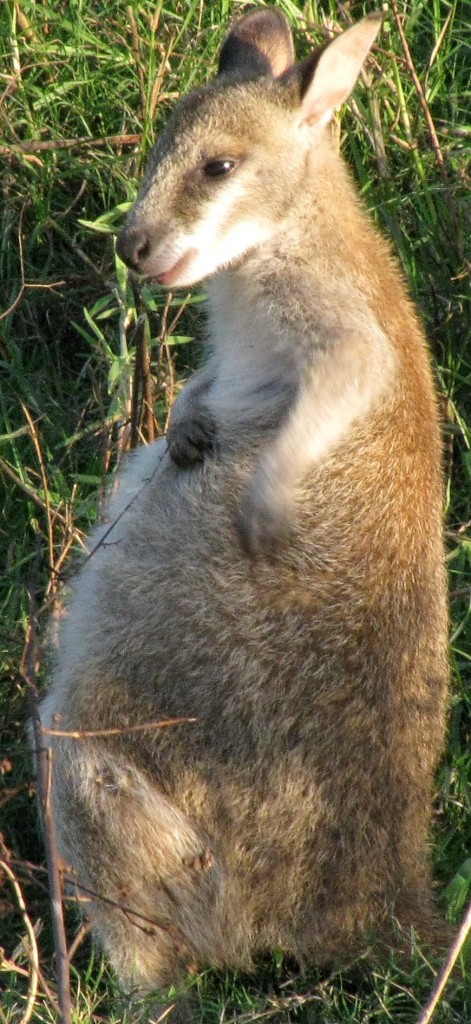
Agile Wallaby (© Vilis Nams)
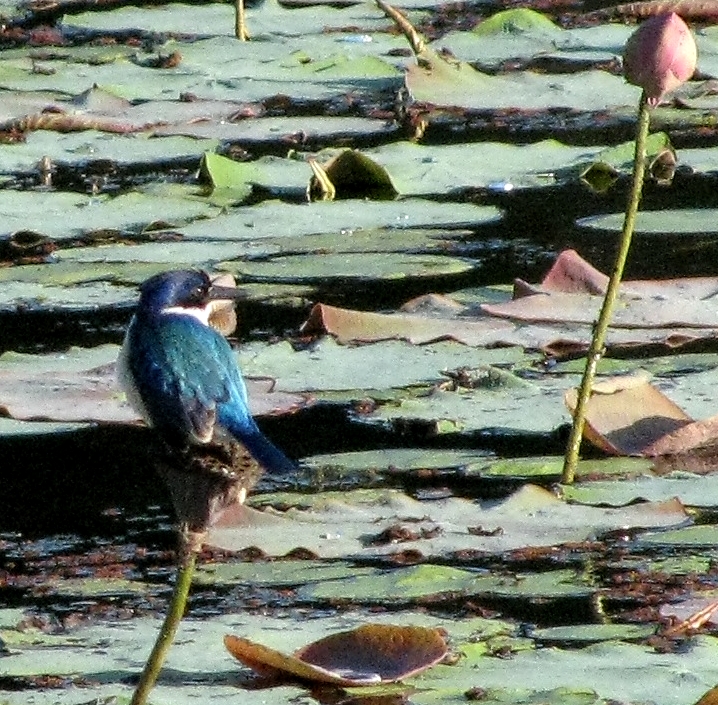
Forest Kingfisher, Lily Pads, and Lotus Bud (© Vilis Nams)
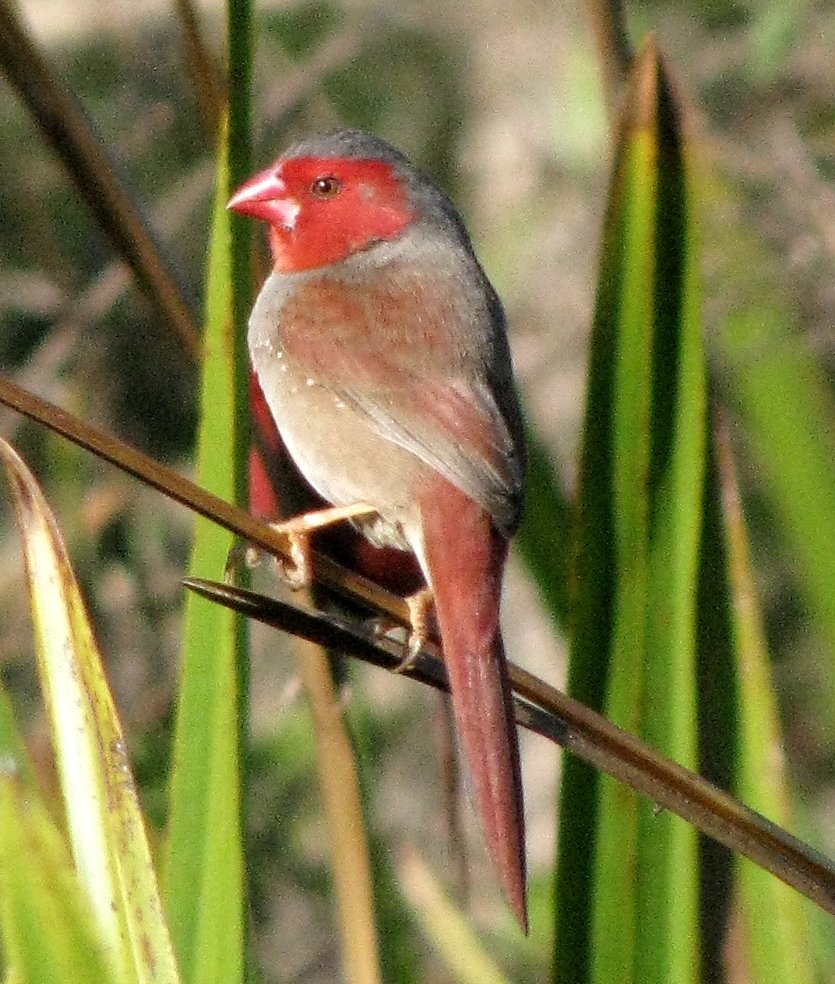
Female Crimson Finch (© Vilis Nams)
After photographing a section of wetland to compose a panoramic view, Vilis walked along above the shore, inciting some large creature to enter the water with a loud splash. We both froze in surprise, wondering what it might be – turtle? crocodile? (croc warning sign at the entrance to the Wetlands). I plan to return to the Wetlands and spend much of a day doing some serious birding, hoping to buy myself a few weeks of lead time in my days versus species competition and to see the endangered grass owl (Tyto capensis), after which the reserve is named.1 I’ll keep my eyes peeled for a good assortment of the 230 bird species listed for the Tyto Wetlands by the Hinchinbrook Shire,1 and also for crocs.
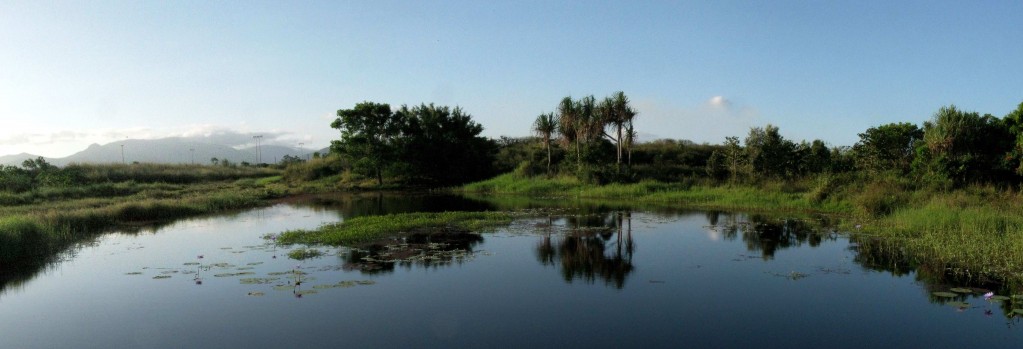
Tyto Wetlands (© Vilis Nams)
Reference:
1. Hinchinbrook Shire. Hinchinbrook, the natural place to be. Tyto Wetlands. Updated 14-Feb-2008. Accessed 20-Jul-2010. http://www.hinchinbrooknq.com.au/content/view/21/79/

